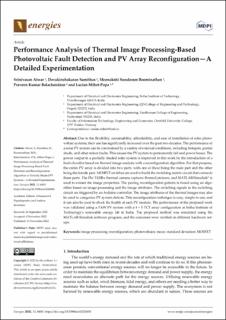| dc.contributor.author | Alwar, Srinivasan | |
| dc.contributor.author | Samithas, Devakirubakaran | |
| dc.contributor.author | Boominathan, Meenakshi Sundaram | |
| dc.contributor.author | Balachandran, Praveen Kumar | |
| dc.contributor.author | Mihet-Popa, Lucian | |
| dc.date.accessioned | 2022-11-11T20:40:02Z | |
| dc.date.available | 2022-11-11T20:40:02Z | |
| dc.date.created | 2022-11-11T14:07:32Z | |
| dc.date.issued | 2022 | |
| dc.identifier.citation | Energies. 2022, 15 (22), Artikkel 8450. | en_US |
| dc.identifier.issn | 1996-1073 | |
| dc.identifier.uri | https://hdl.handle.net/11250/3031493 | |
| dc.description.abstract | Due to the flexibility, sustainability, affordability, and ease of installation of solar photovoltaic systems, their use has significantly increased over the past two decades. The performance of a solar PV system can be constrained by a variety of external conditions, including hotspots, partial shade, and other minor faults. This causes the PV system to permanently fail and power losses. The power output in a partially shaded solar system is improved in this work by the introduction of a fault classifier based on thermal image analysis with a reconfiguration algorithm. For that purpose, the entire PV array is divided into two parts, with one of these being the male part and the other being the female part. MOSFET switches are used to build the switching matrix circuit that connects these parts. The Flir T420bx thermal camera captures thermal pictures, and MATLAB/Simulink® is used to extract the image properties. The pairing reconfiguration pattern is found using an algorithm based on image processing and the image attributes. The switching signals to the switching circuit are triggered by an Arduino controller. The image attributes of the thermal images may also be used to categorize PV system defects. This reconfiguration technique is easy, simple to use, and it can also be used to check the health of each PV module. The performance of the proposed work was validated using a 5 kW PV system with a 4 × 5 TCT array configuration at Sethu Institute of Technology’s renewable energy lab in India. The proposed method was simulated using the MATLAB-Simulink software program, and the outcomes were verified on different hardware setups. | en_US |
| dc.language.iso | eng | en_US |
| dc.publisher | MDPI | en_US |
| dc.rights | Navngivelse 4.0 Internasjonal | * |
| dc.rights.uri | http://creativecommons.org/licenses/by/4.0/deed.no | * |
| dc.subject | image processing | en_US |
| dc.subject | reconfiguration | en_US |
| dc.subject | photovoltaics | en_US |
| dc.subject | mean | en_US |
| dc.subject | standard deviation | en_US |
| dc.subject | MOSFET | en_US |
| dc.title | Performance Analysis of Thermal Image Processing-Based Photovoltaic Fault Detection and PV Array Reconfiguration—A Detailed Experimentation | en_US |
| dc.type | Peer reviewed | en_US |
| dc.type | Journal article | en_US |
| dc.description.version | publishedVersion | en_US |
| dc.rights.holder | © 2022 by the authors. | en_US |
| dc.subject.nsi | VDP::Teknologi: 500 | en_US |
| dc.source.volume | 15 | en_US |
| dc.source.journal | Energies | en_US |
| dc.source.issue | 22 | en_US |
| dc.identifier.doi | 10.3390/en15228450 | |
| dc.identifier.cristin | 2072540 | |
| dc.source.articlenumber | 8450 | en_US |
| cristin.ispublished | true | |
| cristin.fulltext | original | |
| cristin.qualitycode | 1 | |

